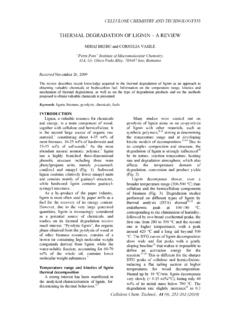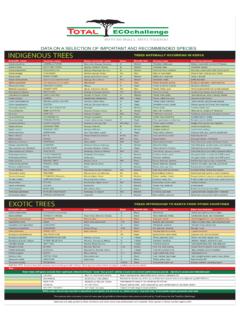Transcription of COOKING OF DRY HIGH-LIGNIN EUCALYPTUS …
1 CELLULOSE CHEMISTRY AND TECHNOLOGY Cellulose Chem. Technol., 51 (9-10), 857-861(2017) COOKING OF DRY HIGH-LIGNIN EUCALYPTUS camaldulensis CHIPS followed BY TCF BLEACHING WITH HYDROGEN PEROXIDE JUHA FISKARI,* TUOMAS VIHEL ,** KY STI RUUTTUNEN,** VILLE ALI-REKOLA,** SANNA HAUTALA** and HERBERT SIXTA** *Laboratory of Organic Chemistry, Department of Chemistry, University of Helsinki, A. I. Virtasen Aukio 1, 00560 Helsinki, Finland **Department of Forest Products Technology, School of Chemical Technology, Aalto University, FIN-02015 Espoo, Finland **Finnish Forest Research Institute (METLA), Box 18, FIN-01301 Vantaa, Finland Corresponding author: Juha Fiskari, To the memory of Acad.
2 Cristofor I. Simionescu, in acknowledgement of his contributions to the cellulose science This paper describes laboratory experiments with EUCALYPTUS camaldulensis grown in South Asia. Pulping of E. camaldulensis is known to be challenging because of its high lignin content. Moreover, E. camaldulensis chips originating from arid and semi-arid regions of South Asia have often a very low moisture content, which further complicates their pulping. In this research, chips with moisture content were screened and the accept fraction underwent a pressurized soaking treatment, which seemingly dissolved carbohydrates, extractives and lignin.
3 The rewetted chips were cooked to a kappa number of 18, oxygen delignified and bleached with hydrogen peroxide. The yield was based on unbleached pulp. Pulp viscosities after COOKING , oxygen delignification and bleaching were 830, 700, and 600 mL/g, respectively. The high active alkali charge in COOKING apparently resulted in low pulp viscosities. In addition to lignin, E. camaldulensis probably contained other polyphenolic compounds, which further consumed alkali. The bleached pulp brightness was ISO.
4 Keywords: conventional batch COOKING , EUCALYPTUS camaldulensis , dry chips, lignin content, hydrogen peroxide bleaching INTRODUCTION E. camaldulensis , also known as red river gum, has proven to be a naturally adaptable species to various soils and climates. It is the most widely planted species in arid and semi-arid regions around the world, mainly in timber Several reasons have fostered the wide distribution of this species. It can stand cold weather and it survives over the dry season.
5 Moreover, E. camaldulensis can grow in saline, commonly flooded soils,2 though Benyon et showed that increasing salinity is associated with reduced tree growth. In the Indian subcontinent, E. camaldulensis forms a major portion of irrigated plantations in hot arid regions in The species is extensively used for various timber products, furniture, as well as pulp and paper making. The chemical composition of E. camaldulensis wood differs somewhat from that of other commonly planted EUCALYPTUS species.
6 In previous studies,5,6 cellulose and hemicellulose contents of samples representing E. camaldulensis of three different ages were measured. The cellulose content varied between and , while the hemicellulose content varied from to According to Lammi,5 the lignin content of E. camaldulensis was determined to be between and In a study by Dutt and Tyagi,6 four-year-old E. camaldulensis samples grown in India had a lignin content of , while Fatehi et reported a lignin content of for the same species grown in Thailand.
7 The latter two values are also much higher than the lignin contents of JUHA FISKARI et al. 858 most EUCALYPTUS species grown on plantations. In the kraft process, high lignin content essentially complicates COOKING and bleaching. Compared to other EUCALYPTUS species, longer COOKING time and higher alkali charges are likely to be needed. Further, high lignin content means the contents of wood polysaccharides (cellulose and hemicelluloses) must be less, which essentially results in lower overall yield in pulping.
8 According to MacLeod,8 there is a linear relationship between the lignin content of wood and the predicted yield of bleachable-grade kraft pulp. Over a yield range of 42-55%, it can be expressed as follows: Pulp yield = - [lignin content, %] + = (1) In addition to its unusually high lignin content, E. camaldulensis trees that originate from arid or semi-arid regions tend to have a low moisture content in wood. As a consequence of this, mills have to feed very dry chips to a digester, which is known to cause further complications in COOKING .
9 Dry chips tend to absorb COOKING liquor rapidly in an uncontrolled and uneven manner, which results in non-uniform COOKING and higher reject. In a laboratory COOKING study comparing normal and dry hardwood chips (with moisture contents of and , respectively),9 a kappa number difference of 5 units was observed while the penalty in reject was (reject contents were of and , respectively). The problem of low moisture content in chips can be partially compensated by longer impregnation time.
10 According to the observations of Zanuttini et al.,10 air-dry hardwood chips require twice as much impregnation time, when compared to never-dried, water-saturated hardwood. Further, the risk of excessive pH reduction in the digester and the resulting lignin condensation and precipitation is much higher than if the chips had a sufficiently high moisture content. These problems are more pronounced with conventional batch COOKING systems, where all COOKING liquor must be charged before the actual COOKING begins.







